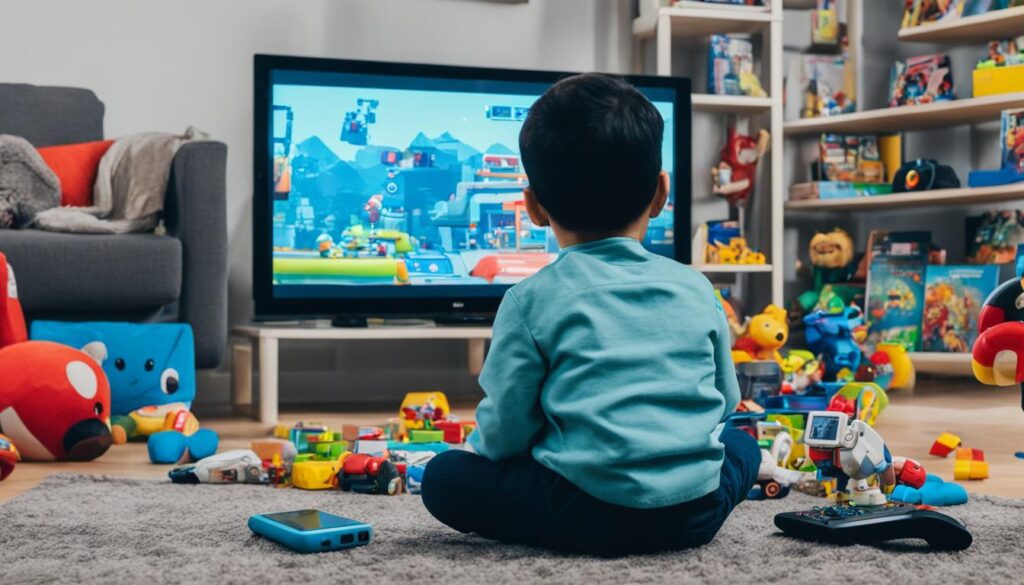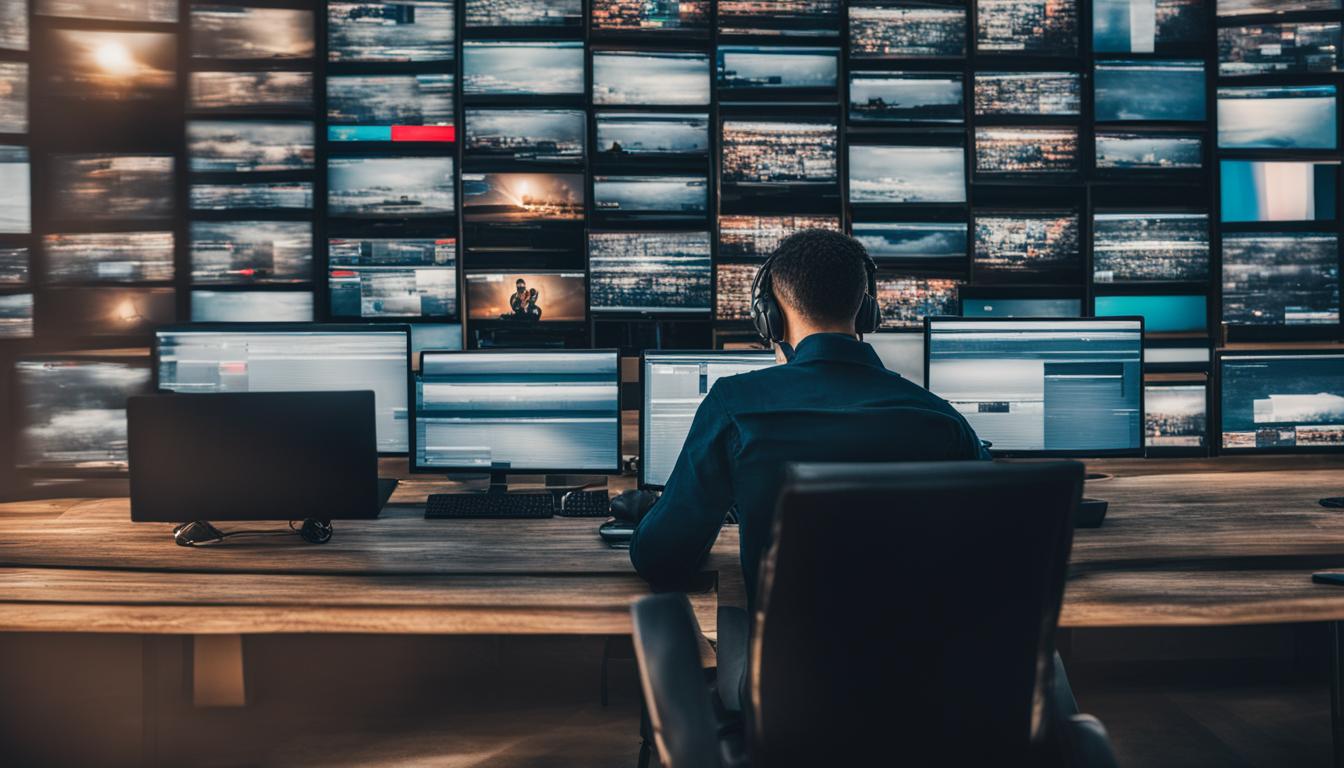Welcome to our article on the negative impact of technology. While technological advancements have brought about significant progress and convenience in various aspects of our lives, it is important to be aware of the drawbacks and adverse effects they can have.
From our health and well-being to societal and privacy concerns, understanding the downsides of technology is crucial in maintaining a balanced and mindful relationship with it.
Contents [hide]
- 1 Psychological and Social Effects of Technology
- 2 Physical Effects of Technology
- 3 Negative Impacts on Daily Life
- 4 Conclusion
- 5 FAQ
- 5.1 What are the negative impacts of technology?
- 5.2 How does technology affect mental health?
- 5.3 What physical effects can technology have on the body?
- 5.4 How does technology affect children?
- 5.5 What are the negative impacts of technology on daily life?
- 5.6 What should be done to mitigate the negative impacts of technology?
- 6 Source Links
Key Takeaways:
- Excessive technology use can lead to various negative effects on our mental, physical, and social well-being.
- Children and teenagers may be particularly vulnerable to the detrimental impacts of technology.
- The overuse of technology can have adverse psychological effects, including feelings of isolation and increased risk of depression.
- Technology use can also have physical effects such as eyestrain, poor posture, sleep problems, and reduced physical activity.
- Children’s developing brains may be more susceptible to the negative impacts of technology, leading to academic and developmental issues.
In the following sections, we will delve deeper into the psychological and social effects of technology, the physical effects it has on our bodies, the impact it has on children, and the negative effects it can have on our daily lives.
By understanding these downsides, we can take steps to mitigate their effects and lead a healthier and more balanced life in our tech-driven world.
Psychological and Social Effects of Technology
The ever-increasing use of technology in our daily lives has brought about various psychological and social effects that are worth considering. One of the significant psychological effects is the feeling of isolation that can arise from excessive technology use.
Research has shown that spending too much time on social media platforms, for example, can lead to higher levels of social isolation, which can impact our mental well-being.
The link between technology use and mental health issues such as depression and anxiety has also been established.
Also read: Urban Transport Tech: Navigating Cities with Weegy
While positive interactions and social support on social media can have a beneficial impact on mental health, negative interactions, and constant social comparison have been found to contribute to higher levels of depression and anxiety.
It is essential to be mindful of our social media consumption and set limits to maintain a healthy psychological state.
The Role of Social Media in Psychological Well-being
“Social media can be a double-edged sword when it comes to our mental health. On one hand, it allows us to connect with others and find support. On the other hand, it can fuel feelings of inadequacy, loneliness, and anxiety when we constantly compare ourselves to others.”
It’s important to recognize that maintaining a healthy psychological state involves finding a balance between our offline and online lives.
While social media can be a valuable tool for connection and communication, it is crucial to prioritize our mental well-being and not let it negatively affect our self-esteem or overall happiness.
Creating boundaries around social media use, such as limiting screen time or designating device-free hours, can help mitigate the negative psychological effects caused by technology.
Taking breaks from social media and engaging in activities that promote face-to-face interactions, exercise, and self-care are also important steps in maintaining a healthy balance.
Also read: Explore New Denture Technology Advances
“Feeling connected in a digital world shouldn’t come at the cost of feeling disconnected from ourselves and others. Striking a balance between our online and offline experiences is key to maintaining healthy psychological well-being.”
By becoming more mindful of our technology use and prioritizing our mental health, we can mitigate the adverse psychological effects and foster a healthier relationship with technology.
Physical Effects of Technology
Technology use can have significant physical effects on your body. Excessive screen time can result in various physical discomforts, including eyestrain, blurred vision, and dry eyes. Staring at screens for extended periods can strain your eyes, leading to discomfort and vision problems.
Poor sitting posture while using mobile devices and computers is also a common issue. When you slouch or hunch over your devices, it can contribute to neck and back pain.
Maintaining proper posture while using technology is crucial to prevent these physical discomforts and promote better spinal alignment.
Another physical effect of technology is related to sleep. The blue light emitted by screens can disrupt your sleep patterns, making it harder for you to fall asleep and resulting in poor sleep quality.
Also read: Discover Ethernet’s Key Features for Connectivity
The overexposure to blue light can suppress the production of melatonin, a hormone that regulates sleep, leading to sleep disturbances and insomnia.
Furthermore, the passive nature of many technological activities can reduce physical activity. Spending long hours sitting and engaging with screens can discourage movement and lead to a more sedentary lifestyle.
Lack of physical activity can negatively impact overall health, including weight gain and increased risk of various chronic conditions.
To mitigate these physical effects, it is important to practice healthy technology habits. Take regular breaks from screens, practice proper sitting posture, and prioritize physical activity in your daily routine.
By being mindful of the physical impacts of technology, you can maintain a healthier balance between your digital life and your physical well-being.

Negative Impacts of Technology on Children
| Developmental Issues | Academic Performance | Attention-Deficit Hyperactivity Disorder (ADHD) | Screen Time Recommendations |
|---|---|---|---|
| Delays in language and social development | Low academic performance | Increased risk of ADHD symptoms | Limit screen time for healthy development |
| Poor physical activity and inactivity | Lack of attention | ||
| Poor sleep quality | |||
| Aggressive behaviors |
Negative Impacts on Daily Life
Technology has a significant impact on our daily lives, but it’s important to recognize that it’s not all positive. The widespread use of technology has brought about several negative consequences that affect our overall well-being and lifestyle.
Lack of Sleep
The constant use of technology, particularly during the late hours, can disrupt our natural sleep patterns. The blue light emitted by devices stimulates our brains and inhibits the production of melatonin, a hormone that regulates sleep.
As a result, many people struggle with insomnia and poor sleep quality, leading to fatigue and decreased productivity during the day.
Social Disconnection
While technology connects us in many ways, it can also contribute to feelings of social disconnection. Excessive reliance on technology for communication can lead to a lack of genuine human interaction and face-to-face connections.
Spending excessive time on social media platforms may create a false sense of connection while increasing feelings of isolation and loneliness.
Sedentary Lifestyle
Technology has made many aspects of life more convenient, but it has also contributed to a more sedentary lifestyle.
The hours spent sitting in front of screens, whether for work or leisure, reduce physical activity and increase the risk of health issues such as obesity, cardiovascular diseases, and musculoskeletal disorders.
Decreased Communication
Although technology provides us with various means of communication, it can also hinder our ability to connect deeply with others.
The constant distractions caused by notifications and the allure of virtual interactions can lead to reduced quality communication with our loved ones. Time spent on devices can take away from meaningful conversations, intimacy, and emotional connection.
Cyberbullying
The rise of technology has unfortunately given rise to cyberbullying, a form of harassment that takes place online.
Through social media platforms and messaging apps, individuals can experience bullying, harassment, and targeted attacks, which can have severe psychological and emotional effects.
Loss of Privacy
As technology advances, the concern for privacy becomes more significant. The constant integration of technology into our lives leaves us vulnerable to the loss of personal information and the invasion of privacy.
Various online platforms and services collect and store our data, often without our full knowledge or consent, raising concerns about data breaches and potential misuse of personal information.
To better understand the negative impacts of technology on daily life, let’s take a look at some numbers:
| Statistics | Impact |
|---|---|
| 72% | Percentage of people who reported using their mobile devices within an hour before bedtime, negatively affecting their sleep quality. |
| 51% | Percentage of adults who stated that technology has made them feel less connected to others. |
| 8+ | Number of hours a day that an average American spends in front of screens. |
| 59% | Percentage of teenagers who reported experiencing cyberbullying. |
| 95% | Percentage of data breaches resulting from human error, putting individuals’ privacy at risk. |
These statistics demonstrate the significant negative impacts of technology on our daily lives, from sleep disruption and social disconnection to cyberbullying and privacy concerns.
It is crucial to be mindful of our technology usage, set boundaries, and prioritize healthy habits to mitigate these negative effects and maintain a balanced and fulfilling life.

Conclusion
While technology has brought many positive changes to our world, it is crucial to acknowledge and address the negative impacts it can have on our lives. The drawbacks of technology can manifest in various ways, affecting our mental and physical health and privacy and even leading to technology addiction.
It is important to be mindful of our technology usage and strike a balance in our daily lives. Taking breaks from technology and setting limits on our screen time can help mitigate the detrimental effects.
By fostering healthy habits and being conscious of our digital consumption, we can maintain a more balanced and fulfilling relationship with technology.
Additionally, privacy concerns related to technology should not be overlooked. With the advancement of digital platforms and devices, the potential for information breaches and cyber threats has increased.
It is essential to stay informed about privacy settings on our devices, use secure online practices, and be cautious about the information we share on digital platforms.
FAQ
What are the negative impacts of technology?
Technology can have various negative effects, including psychological and social impacts such as feelings of isolation, depression, and anxiety. It can also lead to physical effects like eyestrain, poor posture, and sleep problems. In addition, technology can affect children’s development, academic performance, and attention span. It can also have detrimental effects on daily life, including a lack of sleep and privacy concerns.
How does technology affect mental health?
Excessive use of technology, particularly social media, has been linked to increased levels of depression and anxiety. Negative interactions and social comparison on platforms can contribute to these mental health issues. It is important to find a balance and set limits on social media use to maintain healthy psychological well-being.
What physical effects can technology have on the body?
Excessive screen time can lead to eyestrain, blurred vision, and dry eyes. Poor sitting posture while using devices can contribute to neck and back pain. The blue light emitted by screens can disrupt sleep patterns, resulting in poor sleep quality. Additionally, the passive nature of many technological activities can contribute to a lack of physical activity.
How does technology affect children?
Excessive technology use in children can lead to various issues, including low academic performance, lack of attention, delays in language and social development, physical inactivity, poor sleep quality, and even aggressive behaviors. High digital media use in teenagers may increase the risk of developing symptoms of attention-deficit hyperactivity disorder (ADHD). Screen time recommendations emphasize the importance of limiting screen time in children to promote healthy development.
What are the negative impacts of technology on daily life?
Excessive technology use can lead to a lack of sleep due to late-night device use and the stimulation of blue light. It can also contribute to feelings of social disconnection and a sedentary lifestyle. Communication with loved ones may be negatively impacted by technology distractions, leading to decreased intimacy. Additionally, technology has facilitated cyberbullying, invasion of privacy, and potential loss of personal information.
What should be done to mitigate the negative impacts of technology?
To mitigate the negative effects, it is important to take breaks from technology, set limits on usage, and foster healthy habits. Finding a balance between technology use and other activities is crucial. Additionally, practicing good digital hygiene, such as using privacy settings and being mindful of online interactions, can help protect personal information and minimize the negative impacts on mental and physical health.




